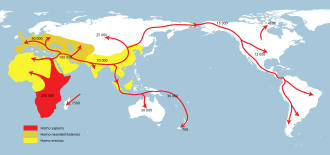
Back هجرات بشرية أولى Arabic Espansión de la humanidá AST প্রারম্ভিক মানব অভিপ্রয়াণ Bengali/Bangla Migracions humanes prehistòriques Catalan Osídlování Země Czech Tidlige menneskelige folkevandringer Danish Ausbreitung des Menschen German Expansión de la humanidad Spanish Giza migrazio goiztiarrak Basque مهاجرت انسانهای اولیه Persian

Homo erectus greatest extent (yellow),
Homo neanderthalensis greatest extent (ochre) during Out of Africa I and
Homo sapiens (red, Out of Africa II), with the numbers of years since they appeared before present.
Early human migrations are the earliest migrations and expansions of archaic and modern humans across continents. They are believed to have begun approximately 2 million years ago with the early expansions out of Africa by Homo erectus. This initial migration was followed by other archaic humans including H. heidelbergensis, which lived around 500,000 years ago and was the likely ancestor of Denisovans and Neanderthals as well as modern humans. Early hominids had likely crossed land bridges that have now sunk.
Within Africa, Homo sapiens dispersed around the time of its speciation, roughly 300,000 years ago.[note 1] The recent African origin paradigm suggests that the anatomically modern humans outside of Africa descend from a population of Homo sapiens migrating from East Africa roughly 70–50,000 years ago and spreading along the southern coast of Asia and to Oceania by about 50,000 years ago. Modern humans spread across Europe about 40,000 years ago.
Early Eurasian Homo sapiens fossils have been found in Israel and Greece, dated to 194,000–177,000 and 210,000 years old respectively. These fossils seem to represent failed dispersal attempts by early Homo sapiens, who were likely replaced by local Neanderthal populations.
The migrating modern human populations are known to have interbred with earlier local populations, so that contemporary human populations are descended in small part (below 10% contribution) from regional varieties of archaic humans.[note 2]
After the Last Glacial Maximum, North Eurasian populations migrated to the Americas about 20,000 years ago.[6][7] Arctic Canada and Greenland were reached by the Paleo-Eskimo expansion around 4,000 years ago. Finally, Polynesia was populated within the past 2,000 years in the last wave of the Austronesian expansion.
- ^ Schlebusch; et al. (3 November 2017). "Southern African ancient genomes estimate modern human divergence to 350,000 to 260,000 years ago". Science. 358 (6363): 652–655. Bibcode:2017Sci...358..652S. doi:10.1126/science.aao6266. PMID 28971970.
- ^ Stringer, C (2012). "What makes a modern human". Nature. 485 (7396): 33–35. Bibcode:2012Natur.485...33S. doi:10.1038/485033a. PMID 22552077. S2CID 4420496.
- ^ Lohse, K; Frantz, L.A.F. (2014). "Neandertal Admixture in Eurasia Confirmed by Maximum-Likelihood Analysis of Three Genomes". Genetics. 196 (4): 1241–1251. doi:10.1534/genetics.114.162396. PMC 3982695. PMID 24532731.
- ^ Reich, D; Green, RE; Kircher, M; Krause, J; Patterson, N; Durand, EY; Viola, B; Briggs, AW; Stenzel, U; Johnson, PL; Maricic, T; Good, JM; Marques-Bonet, T; Alkan, C; Fu, Q; Mallick, S; Li, H; Meyer, M; Eichler, EE; Stoneking, M; Richards, M; Talamo, S; Shunkov, MV; Derevianko, AP; Hublin, JJ; Kelso, J; Slatkin, M; Pääbo, S (2010). "Genetic history of an archaic hominin group from Denisova Cave in Siberia". Nature. 468 (7327): 1053–1060. Bibcode:2010Natur.468.1053R. doi:10.1038/nature09710. PMC 4306417. PMID 21179161.
- ^ Hammer, M.F.; Woerner, A.E.; Mendez, F.L.; Watkins, J.C.; Wall, J.D. (2011). "Genetic evidence for archaic admixture in Africa". Proceedings of the National Academy of Sciences. 108 (37): 15123–15128. Bibcode:2011PNAS..10815123H. doi:10.1073/pnas.1109300108. PMC 3174671. PMID 21896735.
- ^ Zimmer, Carl (23 September 2021). "Ancient Footprints Push Back Date of Human Arrival in the Americas". The New York Times. ISSN 0362-4331. Retrieved 8 April 2022.
- ^ Gershon, Livia (24 September 2021). "Prehistoric Footprints Push Back Timeline of Humans' Arrival in North America". Smithsonian Magazine. Retrieved 8 April 2022.
Cite error: There are <ref group=note> tags on this page, but the references will not show without a {{reflist|group=note}} template (see the help page).